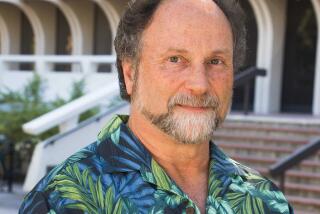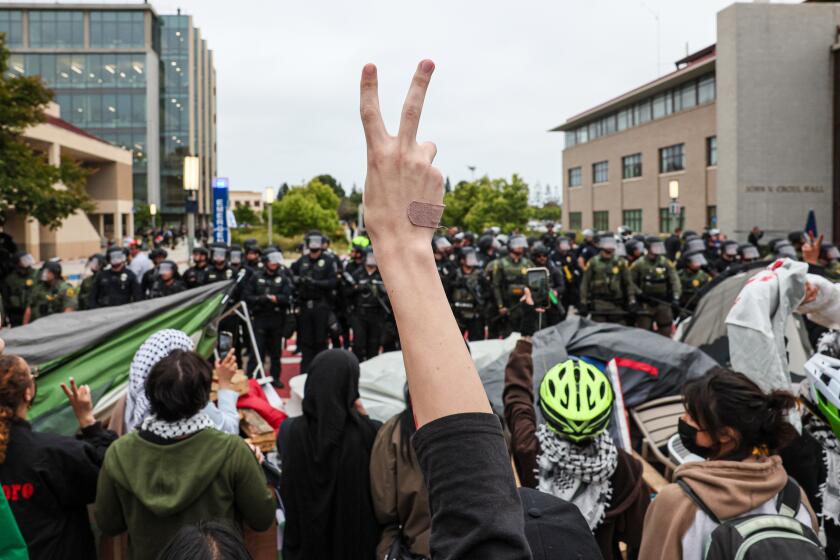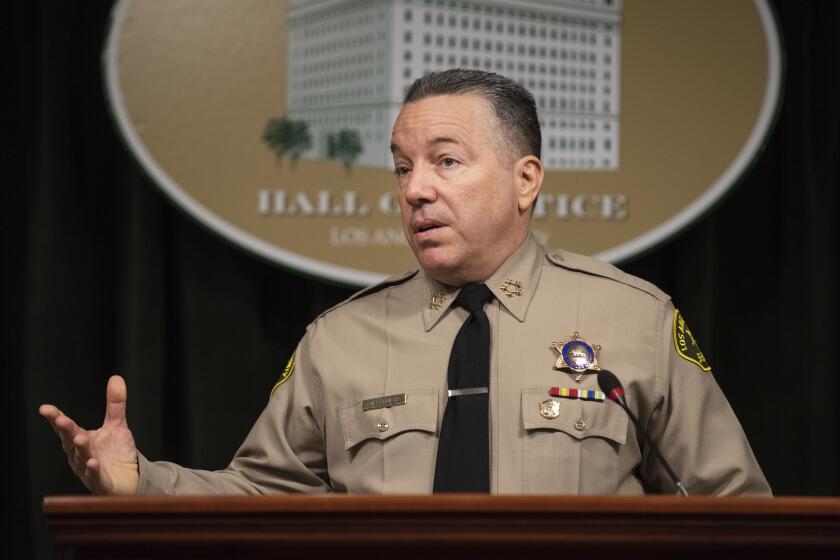Shaking the ‘Warrior Cop’ Mentality a Test of City’s Will
IF Los Angeles can be defined by a psychological trait, it would be willfulness.
The force of will, sprinkled with greed, brought water to the city in the early 20th century and allowed it to grow. Willful civic leaders gave Los Angeles its port in 1907, cleaned out its corrupt leadership in favor of Progressive reforms and even supplied it with some of its cultural gems, including the Dorothy Chandler Pavilion and, more recently, Disney Hall.
But, as the newly released report by the Blue Ribbon Rampart Review Panel argues, no such exercise of will has been able to dislodge a powerful subculture within the Los Angeles Police Department, one that has done much to harm the city in recent generations.
Colorfully dubbed “warrior cops,” an evolving clique of aggressive LAPD officers who rely on force and intimidation has resisted 40 years of attempts to manage crime in the city differently.
The warrior cop -- known more blandly within the LAPD as the “proactive police officer” -- was the invention of Police Chief William H. Parker, who headed the LAPD from 1950 to 1966. That style of policing and the officers who embrace it have done much to protect Los Angeles in the years since. In many ways, they are symbolic of the city’s police -- think “Dragnet,” “The New Centurions.”
But officers who take it too far, who cross the line from command presence to unlawful force, have also been responsible for devastation. Their racial callousness and penchant for brutality fueled the Watts riots of 1965 as well as the riots that erupted after the Rodney G. King verdicts in 1992. They were responsible for the Rampart scandal, and they have supplied much of the tension between police and minority communities that was a defining feature of late-20th century Los Angeles.
No commission, no mayor and no chief has ever succeeded in bringing that culture to heel; indeed, it remains iconic in the city’s police force.
“Most LAPD officers are not warrior cops,” this latest report concludes. “But most LAPD heroes are.”
Warren M. Christopher, the former secretary of state who chaired the Christopher Commission in 1991, agreed that the persistence of that police culture is troubling.
“This is something that has worried me for a long time,” he said. “It’s much too glib to talk about bad apples. It’s much broader than that.”
Now, the burden of confronting that subculture moves to Mayor Antonio Villaraigosa, and it is unclear how committed he will be to the challenge. Since assuming office a year ago, Villaraigosa has offered unflinching support for Chief William J. Bratton and expressed confidence that the LAPD is heading in the right direction. Last week, the mayor said he would also play an “active” role in seeing that the Rampart reforms are put in place. “We are very fortunate that we have a great command staff, a great chief and a police commission who are reform-minded,” he said.
But with the panel’s report comes a reminder that reform requires more than rhetorical support to protect the city from violence triggered by its most aggressive police officers.
The report goes so far as to maintain that many officers fail even to see the warrior cop as a problem.
“Blue-ribbon elites,” the report finds, “often fail to understand that what they view as ‘problems’ needing fixing are policing norms that officers defend.”
When he became chief in 1950, Parker set out to break the LAPD’s reputation for corruption, one it shared with other big-city police agencies. Officers walking beats were accused of taking bribes. So Parker put officers in squad cars and limited their contact with the public -- police were expected to roll to crimes, arrest suspects and return them to stations. The opportunities for graft were minimized as the contact with the public was curtailed.
But that had other consequences: Parker’s overwhelmingly white force glided through the city, plucking suspects from the streets and expanding its influence by quickly resorting to force. The notion of the LAPD as an invading army took hold in those years, and police-community relations deteriorated alarmingly.
In 1965, Watts exploded after a confrontation between a highway patrol officer and a black man drew a crowd that turned on the officer. Six days of violence followed. Analyzing that riot in its aftermath, the McCone Commission noted that just 10% of the department’s officers were disciplined in the year before the riots. That 10%, however, contributed to a “deep and long-standing schism between a substantial portion of the Negro community and the Police Department.”
The McCone Commission’s report, frequently cited in the Rampart review unveiled this week, recommended a stronger civilian Police Commission, creation of an inspector general to study police misconduct, better investigations of citizen complaints and improved community relations, among many other things. Those would become recurring themes in the years ahead.
By 1992, relations between the Police Department and minority communities, particularly African Americans, had reached another of their periodic nadirs. The 1991 beating of Rodney G. King, captured on videotape, supplied what many saw as welcome proof of the brutality and racism of certain officers. When four of those officers were acquitted in state court, Los Angeles erupted for the second time in 27 years, again with the loss of scores of lives and billions of dollars in property damage.
As before, the city turned to a commission, this time headed by Christopher, who had served with the McCone Commission. Christopher’s panel also identified a core of problem officers within LAPD, finding that about 5% of the city’s 7,850 police officers were responsible for 20% of its uses of force. Of those, 44 officers had received six or more complaints of excessive force in the previous five years.
“By their misconduct, this group of officers tarnishes the reputations of the vast majority of LAPD officers who do their increasingly difficult job in policing the city with courage, skill and judgment,” the Christopher Commission wrote. Its recommendations included a few familiar ones: strengthen the Police Commission, create an inspector general, improve community relations.
Unlike the McCone Commission report, which was widely ignored, the Christopher Commission succeeded in winning public approval for its major recommendations, and most have been implemented in recent years. The commission gained greater control over the police chief, for instance, and the city at last created an Office of the Inspector General.
But this week’s Rampart report provides the latest affirmation that even those much-heralded reforms have not rid the department of its nettlesome core.
“Guys are not talking,” one sergeant told the panel, “just shooting.”
For Villaraigosa, such testimony and the report’s conclusions suggest that he ignores that culture at his peril.
The mayor already has tapped the city’s trash fee to fund a buildup of the Police Department, but he has spent far less capital to identify its miscreants and either discipline or fire them. He sought, for instance, to limit the reach of the costly-to-administer federal consent decree that sets the parameters of LAPD reform. The Rampart panel, by contrast, describes that decree as the principal tool of the federal court, “the only entity with the independence, power and sustained focus capable of ensuring that the city and LAPD maintain current reform efforts.”
Despite the pleadings of Villaraigosa and the U.S. Department of Justice, the judge overseeing that decree extended it anyway.
Christopher has argued for years that the LAPD should tighten pre-employment checks of officer candidates and institute periodic re-screening of officers to identify those who may have grown insensitive in the course of their careers. “Police work is very hard,” he said. “It should not surprise anyone that it is mind-altering to some.”
No proposal for such screening currently stands before the city, despite its recommendation in the original Christopher report and Christopher’s advocacy for it over the last decade.
Indeed, pre-employment screening by the LAPD is actually being relaxed, not made more rigorous, as the department struggles to add more officers.
Erwin Chemerinsky, a Duke University law professor and another veteran observer of the LAPD, added that any genuine attempt to curb the department’s most aggressive officers requires implementation of the long-delayed computerized officer-tracking system as well as steps to break down the notorious “code of silence” under which officers are said to cover for one another. One possible step in that direction, he said: allowing officers to make anonymous complaints regarding misconduct, which would shield them from retaliation.
With the latest report now finished, the question for Villaraigosa is whether he will move on proposals such as those, and whether he will rise to a public challenge to invest in the department in a way that might change its tone and wash out its warriors. It would, the report acknowledges, require much new investment as well as a sustained act of will.
*
(BEGIN TEXT OF INFOBOX)
Voices of Rampart
Without identifying officers by name, the panel studying the LAPD published some of its comments and perceptions.
A sample follows below and on Page B3.
‘Homicides were out of control -- crime was ridiculous. There was a dead body every day. We had an “us against them” mentality where winning was what mattered. This led to slowly taking shortcuts.’
Sergeant,
almost 20 years
in the LAPD
*
‘You get what you pay for.... The cops I work with do what we tell them.... If you tell them to go out with four “A Cars” and handle the division, they will do the best they can, but don’t look -- you don’t want to watch.’
Supervisor,
more than 25 years
in the LAPD
*
Eyewitnesses to Rampart
What LAPD officers say about policing and the roots of the Rampart scandal:
WARRIOR MENTALITY
‘When I went to Southeast, [everybody was] saying, “We want to do real police work.” It is code. To say I want to go to South Bureau to do “real police work” means I can treat people like criminals ... and there will be no beefs against me.... Because of the nature of crime [in South Bureau], it is so dangerous, officers have to protect themselves. So we can excuse officers when people are treated badly.’
Sergeant,
more than 20 years in the LAPD
RAMPART CLIMATE
‘The mandate from City Hall was, “We want safe streets.” The captain says, “Get the streets clean at all costs.” So when a young cop stops a gang member, he pats him down and says, “Look what is on [the] sidewalk -- a rock [of cocaine].” They write a report describing that it was in plain view, then they have to lie in court. This creates lie after lie.’
Detective,
more than 25 years in the LAPD
‘I think where we lost connection was in the six months after’ the Rodney G. King beating. ‘When that first hit, every sergeant and captain hung their head and said, “Boy, did we screw up” for two or three days. But as the community, the L.A. Times and politicians beat us up, a bunker mentality took over.... All of a sudden you hear from sergeants, “Nobody supports the troops -- not the politicians, not the command, not the (Police) Commission.” ’
Retired command staff
BARRIERS TO REFORM
‘The real crime is that the people in charge of the city haven’t increased the size of LAPD. Supervisors cannot do their job. A lieutenant can’t get in the field.... No matter what [the panel] comes up with, it is just talk without resources.’
LAPD command staff
Source: “Rampart Reconsidered, the Search for Real Reform Seven Years Later,” Blue Ribbon Rampart Review Panel. The full report is available at www.lapdonline.org.
More to Read
Sign up for Essential California
The most important California stories and recommendations in your inbox every morning.
You may occasionally receive promotional content from the Los Angeles Times.











